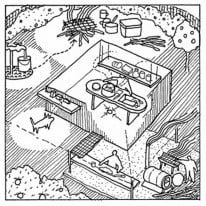B4 - Improving nutrition – the ability to store, prepare and cook food

Australian Aboriginal and Torres Strait Islander people have high rates of obesity, diabetes, cardiovascular disease and renal disease. The primary determinants of these conditions are poor diet and lack of exercise. Poor nutrition is also a critical determinant of infectious diseases in children. In remote locations, changing to a healthy diet is complicated by factors such as low household income, high cost of food, local store management practices, and the ability to store, prepare and cook food at home.
A reliable water supply is critical for improving nutrition. Drinking water is essential for life and potable water is also required for preparing food, cleaning food utensils and cooking equipment, and for washing teeth and dental appliances.
When designing a house, consult residents about their cooking preferences. Consider the type of foods that are stocked in the local store and find out what foods might be gathered from gardens, the sea or the bush. Find out how many people are likely to use the house, whether these people belong to different family or generational groups, what traditions the family observe about the cooking and eating of food, and whether the kitchen might be used by people with disabilities. Ask about how food is prepared and what types of stoves, ovens, appliances and utensils are used for cooking. This information indicates the ways that food might be stored, prepared and cooked in and around the house and is essential for the design of indoor and outdoor cooking places and kitchen that will suit the needs of residents.
The Australian national survey data show that only about 12% of over 6,000 houses tested between 2004 and 2024 have all the functioning health hardware needed to perform the fundamental healthy living practice of improving nutrition by being able to store, prepare and cook food.
Most kitchen areas in surveyed houses showed poor design and construction, use of poor quality materials and a lack of maintenance. The poorest performing items in the house were:
- the kitchen bench material and the splash back behind the kitchen sink
- a lack of high level storage out of the easy reach of children and animals
- all parts of the stove and oven – these were generally electric with failed controls, elements and seals
- the temperatures of refrigerators and freezers, when available.
